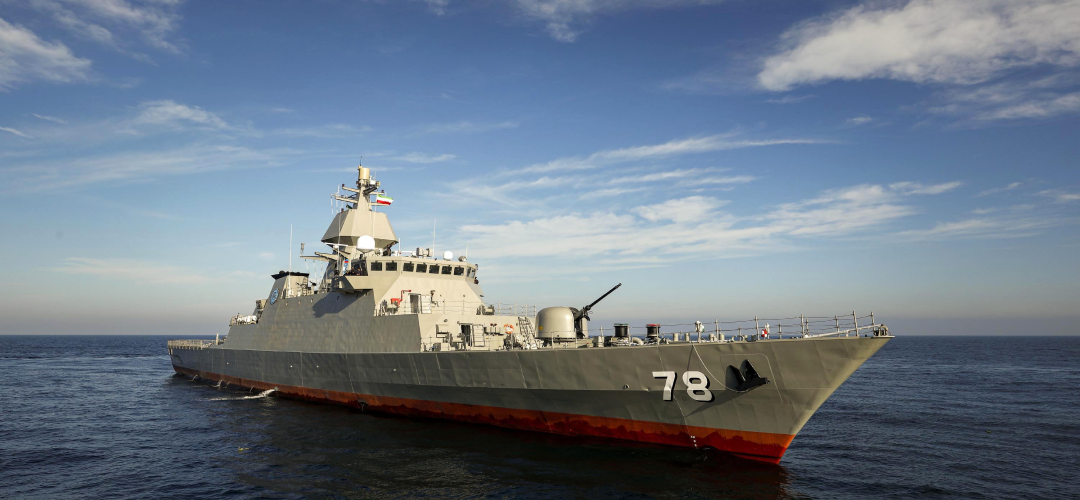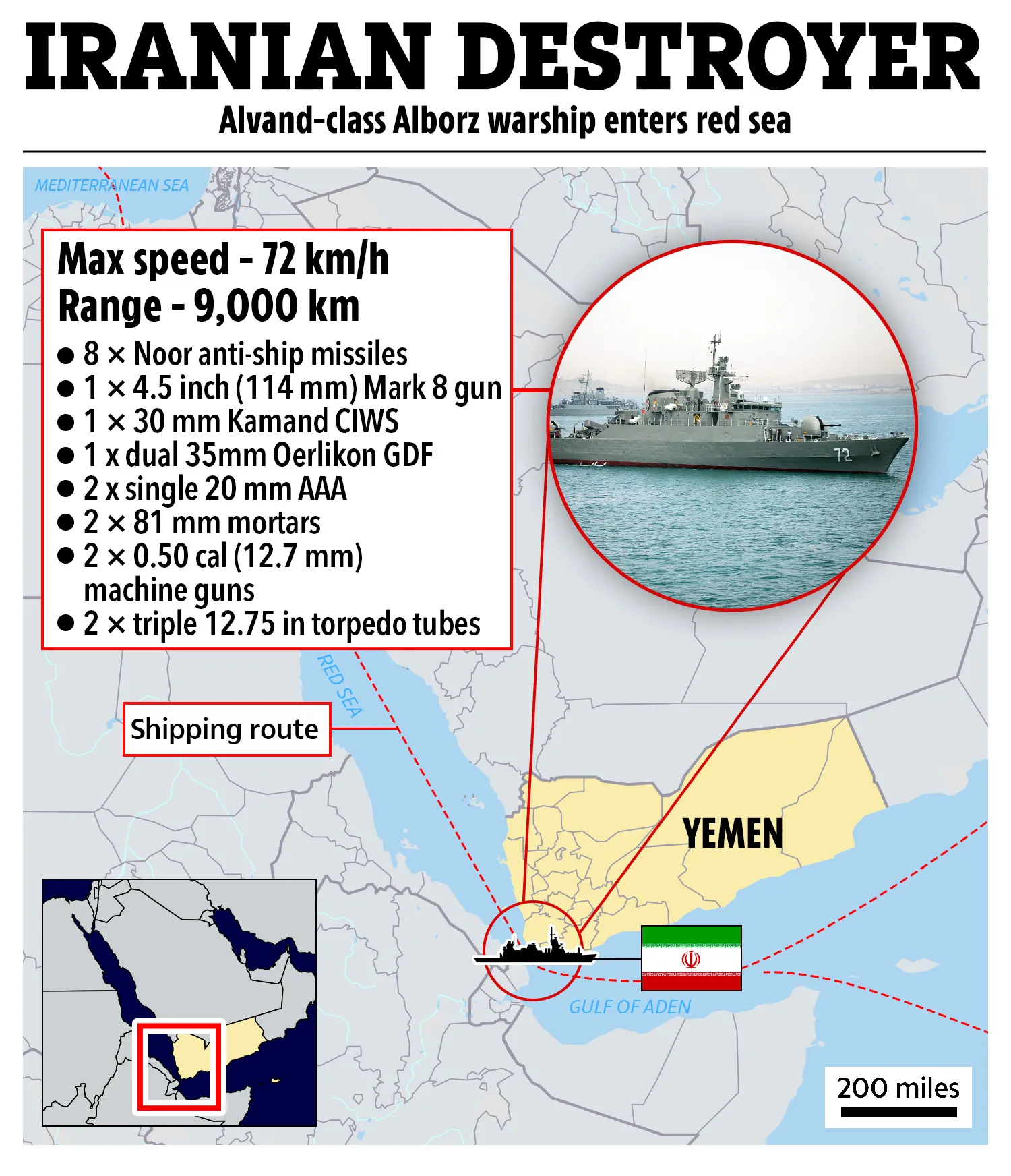Dangerous Waters
January 6, 2024 | Expert Insights

The Red Sea, a vital artery for global trade, has become a flashpoint of tension with the recent entry of Iran's Alborz warship. This move comes amidst escalating attacks by Yemen's Houthi rebels and a burgeoning international response, raising concerns about the potential disruption of maritime traffic and the wider geopolitical implications.
Background
The Red Sea, once a relatively calm shipping lane, has become a simmering cauldron of tension since the Israel-Hamas conflict. Houthi rebels, motivated by their perceived alignment with the Palestinian cause and allegedly under the benign eyes of Teheran, have taken on the might of Western naval power. Tapping on the global registry of shipping navigating the seas of the world, the Houthi para-military has been selectively targeting ships that they claim to have some connection to Israel, irrespective of the flag that the ships are flying. Generously supplied with drones and missiles, allegedly by their mentor Iran, they have virtually turned the narrow Red Sea into a no-go area for merchant vessels. Even the sea lanes hugging the Indian mainland have not been spared, as merchant ships heading for Indian ports have been targeted about 250 km from the coastline.
These attacks, ranging from missile strikes to drone assaults, have sent shockwaves through the region, raising fears of a wider conflict. The entry of Iran's Alborz warship into this volatile mix adds another layer of complexity. Though a vintage platform, having been sold to a pre-revolution Iran by Great Britain in 1969, its appearance is significant, more so as it comes against the backdrop of Houthis raining missiles on neutral shipping in the Red Sea and a retaliatory strike by the US Navy that sank three Houthi boats attacking a container ship leading to the death of ten Houthi militiamen.
A word about the Houthis. It is Iranian proxy, a Zaidi Shia group hailing from Yemen's north, that rose to prominence in 2004, claiming marginalization and discrimination by the Sunni-dominated government. Their grievances stemmed from economic neglect, political exclusion, and perceived American influence under President Ali Abdullah Saleh. Their armed rebellion, initially focused on northern Yemen, gained momentum during the Arab Spring in 2011, culminating in their capture of the capital Sana'a in 2014. The Houthis' rise triggered a complex conflict. A Saudi-led coalition, backed by the U.S. and UK, intervened in 2015 to restore the internationally recognized government. This intervention, fuelled by regional rivalries and sectarian narratives, plunged Yemen into a devastating war marked by airstrikes, civilian casualties, and the world's worst humanitarian crisis. However, it made little progress towards a definite settlement of the conflict. Now, as Saudi Arabia and its partner UAE try to extricate themselves from this mess, the Houthis are apparently encouraged to play a larger extra-regional role.
Analysis
With multiple militaries operating in close proximity, the risk of miscalculation is dangerously high. A single misinterpreted action, a stray missile, or a misinterpreted communication could spark a chain reaction of escalatory responses. The consequences of such a miscalculation could be disastrous, leading to widespread civilian casualties, damage to critical infrastructure, and a disruption of global trade on a scale not seen in decades.
With over 10 per cent of the world's oil passing through its waters, any disruption to this flow could have severe economic repercussions. Shipping companies are already rerouting their vessels, adding days to journeys and inflating transportation costs. Consumers ultimately bear these increased costs through higher prices for everyday goods. Moreover, the crisis could lead to a rise in insurance premiums for vessels navigating the Red Sea, further deterring shipping and potentially pushing companies to seek alternative routes. This could have a long-term impact on the region's energy landscape, as oil producers may be forced to rely on more expensive pipelines for transportation.
The volatile winds of tension swirling in the Red Sea have drawn diverse responses from the international community, each driven by their interests and calculations. The West, led by the U.S. and UK, has adopted a resolute stance in the face of the Houthi threat. Condemnations of the attacks have been swift and vocal, followed by the deployment of Operation Prosperity Guardian, a U.S-led naval coalition tasked with deterring further disruptions. Airstrikes remain a potential option, a grim foreshadowing that risks sparking wider conflict. This proactive approach reflects the West's concern for the free flow of trade and its longstanding rivalry with Iran, which they perceive as emboldening the Houthis.
Iran's entry into the fray presents a puzzle wrapped in an enigma. Officially, the Alborz warship's presence is framed as a commitment to securing shipping lanes, a longstanding Iranian policy in the region. However, this explanation rings hollow for many, given Iran's close ties to the Houthis and its history of using proxy groups to exert influence. Sceptics see the warship as a calculated move to challenge Western dominance in the Red Sea and test the resolve of the US-led coalition. Whether Iran seeks outright confrontation or merely leverages the situation for strategic gains remains to be seen.
Beyond the stark divide between the West and Iran lies the hesitant dance of the broader international community. While pledging support for Operation Prosperity Guardian, the EU has refrained from endorsing direct military action. Individual European powers, like France and Spain, prefer independent patrols, wary of being drawn into a U.S.-created quagmire. This cautious approach reflects their desire to avoid antagonizing Iran, maintain trade through the Red Sea, and prioritize diplomatic solutions over military escalation.
Despite all the bonhomie on Indo-Pacific strategy, India has also stayed away from the U.S.-led coalition, preferring to deploy significant platforms to protect ships heading towards Indian ports. Perhaps New Delhi is wary of joining a military coalition that may suddenly turn upon Iran.
Assessment
- The humanitarian crisis in Yemen, already the worst in the world, could worsen significantly if the conflict escalates. Millions of civilians rely on food and medical supplies delivered through the Red Sea, and any disruption could have devastating consequences. Clearly, the Houthis have not thought through the consequences logically, nor is Teheran trying to control them. This makes for a dangerous mix.
- Ultimately, the international response to the Red Sea crisis hangs in a delicate balance. Iran's enigmatic manoeuvring matches the West's resolve, while the rest of the world walks a tightrope between engagement and restraint. Finding a peaceful resolution through dialogue and multilateral action remains the only path to calm the turbulent waters of the Red Sea and prevent a potentially disastrous conflagration.
- De-escalation and a peaceful resolution to the Yemeni conflict are crucial to restoring stability and securing safe passage for global trade. However, the volatile mix of heightened tensions, miscalculation risks, and potential trade disruption underscores the need for all actors involved to exercise restraint and engage in meaningful dialogue to prevent a wider conflict and ensure the continued flow of vital goods through this critical waterway.









Comments